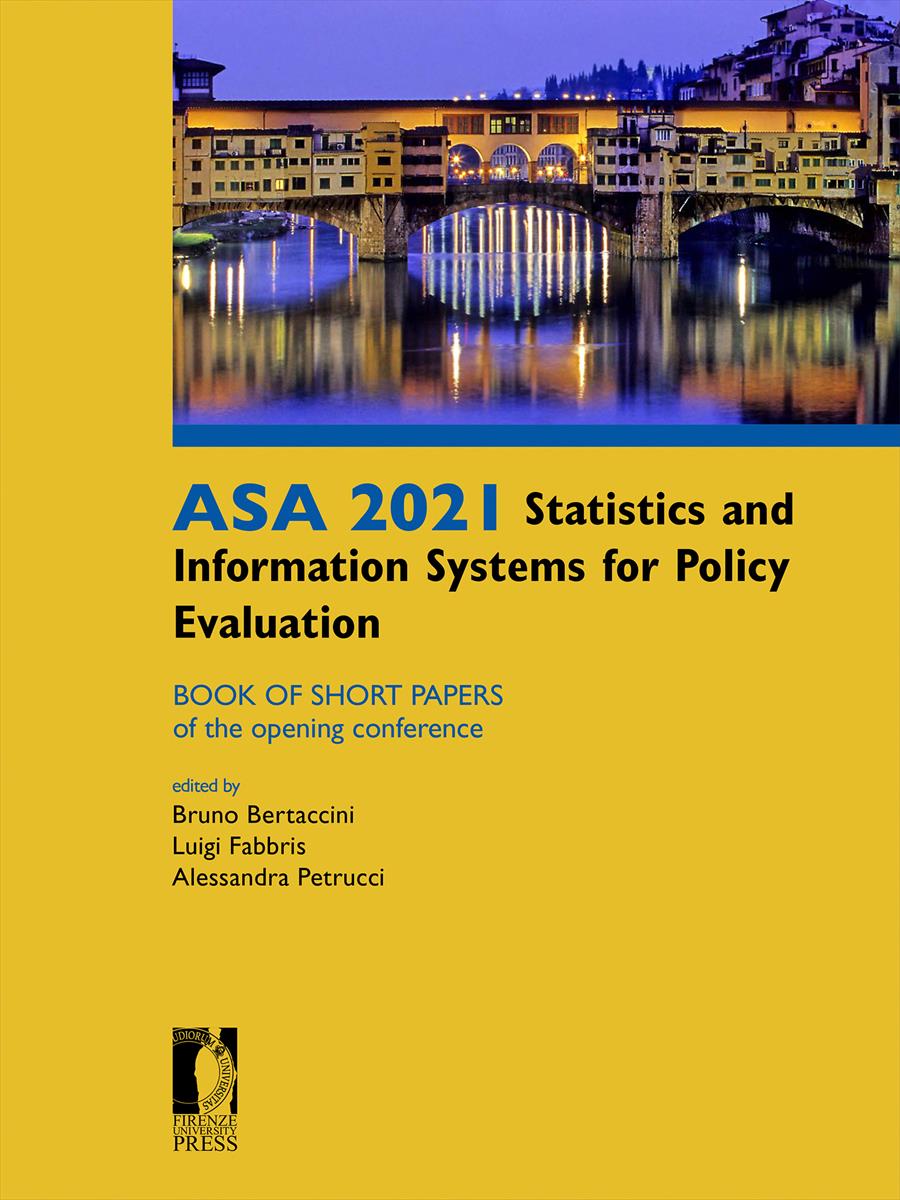- ASA 2021 Statistics and Information Systems for Policy Evaluation
- Edited by Bruno Bertaccini, Luigi Fabbris, Alessandra Petrucci
Innovation and sustainability: the Italian scenario
- Rosanna Cataldo
- Maria Gabriella Grassia
- Paolo Mazzocchi
- Claudio Quintano
- Antonella Rocca
- © 2021 Author(s) |
- CC BY 4.0
- DOI: 10.36253/978-88-5518-304-8.15
Society and policy makers demand innovation systems oriented towards several goals of sustainable development. Therefore, recent literature has dedicated a growing interest to both innovation and sustainability in the pursuit of environmental, economic and social development; in addition, the emerging topic of ‘sustainable innovation’ (and ‘eco-innovation’) seems to combine the main features of them. The definition of these concepts has been significantly changed during the last decades, and a broad discussion continues today about which indicators should be used to measure innovation, sustainability and their combination. The current paper investigates this relationship, and - in the authors’ opinion - the research question connected to the impact of the innovative product (and service and process) solutions on sustainability can be addressed by means of a stable theoretical framework. To study the interaction between innovation and sustainability, the usage of specific territorial features might represent a useful perspective to manage short-and long-term environmental and economic issues. As for the theoretical model, the present article considers a specific technique suitable for investigating the entire set of characteristics involved in the model. From a public makers and managerial point of view, the possibility of improving the firm’ efficiencies in terms of several dimensions of sustainable innovation represents a relevant topic that must be encouraged.
- Keywords:
- Sustainability,
- Innovation,
- Composite Indicators,
University of Naples Federico II, Italy - ORCID: 0000-0002-6324-8252
University of Naples Federico II, Italy - ORCID: 0000-0002-7128-7323
University of Naples Parthenope, Italy - ORCID: 0000-0002-6632-314X
University of Naples Suor Orsola Benincasa, Italy - ORCID: 0000-0001-8315-8476
University of Naples Parthenope, Italy - ORCID: 0000-0001-8171-3149
- Carrillo-Hermosilla, J., del Río, P., Könnölä, T. (2009). Eco-innovation. When Sustainability and Competitiveness Shake Hands. Palgrave. London (UK).
- Carrillo-Hermosilla, J., del Río, P., Könnölä, T. (2010). Diversity of Eco-Innovations: Reflections from Selected Case Studies. Journal of Cleaner Production, 18 (10–11), pp. 1073–1083.
- Durst, S., Edvardsson, I. R. (2012). Knowledge Management in SMEs: A Literature Review. Journal of Knowledge Management, 16 (6), pp. 879–903.
- Dziallas, M., Blind, K. (2019). Innovation Indicators Throughout the Innovation Process: An Extensive Literature Analysis. Technovation, 80-81, pp. 3–29.
- European Commission (2019). Regional Innovation Scoreboard, Luxembourg, available at https://ec.europa.eu/growth/sites/growth/files/ris2019.pdf
- European Commission (2020). European Innovation Scoreboard, Luxembourg, available at https://ec.europa.eu/docsroom/documents/42981/attachments/1/translations/en/renditions/nativ e
- Gössling, T., Rutten, R. (2007). Innovation in Regions. European Planning Studies, 15, pp. 253– 270.
- Hagedoorn, J., Cloodt, M. (2003). Measuring Innovative Performance: Is there an Advantage in using Multiple Indicators? Research Policy, 32(8), pp. 1365–1379.
- Hair, J.F., Sarstedt, M., Ringle, C.M., Gudergan, S.P. (2017), Advanced Issues in Partial Least Squares Structural Equation Modeling, Sage, Los Angeles.
- Makkonen, T, van der Have, R. P. (2013). Benchmarking Regional Innovative Performance: Composite Measures and Direct Innovation Counts. Scientometrics, 94(1), pp. 247–262.
- Organisation for Economic Co-operation and Development - OECD (2018). Oslo Manual 2018: The Measurement of Scientific and Technological Activities: Guidelines for Collecting, reporting and using data on Innovation. OECD, Paris.
- Ringle, C.M., Sarstedt, M. and Straub, D.W. (2012). Editor’s comments: A critical look at the use of pls-sem in “mis quarterly”. In MIS quarterly, iii–xiv.
- Rothwell, R. (1992). Successful industrial innovation: Critical factors for the 1990s. R&D Management, 22(3), pp. 221–238.
- Smith, K. (2005). Measuring Innovation. In Fagerberg, J., Mowery, D., Nelson, R. (Eds.), The Oxford handbook of innovation. Oxford University Press, New York, pp. 148–177.
- Sood, A., Tellis, G. J. (2005). Technological Evolution and Radical Innovation. Journal of Marketing, 69(3), pp. 152–168.
- Wetzels, M., Odekerken-Schröder, G., Van Oppen, C. (2009). Using PLS Path Modeling for Assessing Hierarchial Construct Models: Guidelines and Empirical Illustration. MIS Quarterly, 33(1), pp. 177–195.
Chapter Information
Chapter Title
Innovation and sustainability: the Italian scenario
Authors
Rosanna Cataldo, Maria Gabriella Grassia, Paolo Mazzocchi, Claudio Quintano, Antonella Rocca
Language
English
DOI
10.36253/978-88-5518-304-8.15
Peer Reviewed
Publication Year
2021
Copyright Information
© 2021 Author(s)
Content License
Metadata License
Bibliographic Information
Book Title
ASA 2021 Statistics and Information Systems for Policy Evaluation
Book Subtitle
Book of short papers of the opening conference
Editors
Bruno Bertaccini, Luigi Fabbris, Alessandra Petrucci
Peer Reviewed
Publication Year
2021
Copyright Information
© 2021 Author(s)
Content License
Metadata License
Publisher Name
Firenze University Press
DOI
10.36253/978-88-5518-304-8
eISBN (pdf)
978-88-5518-304-8
eISBN (xml)
978-88-5518-305-5
Series Title
Proceedings e report
Series ISSN
2704-601X
Series E-ISSN
2704-5846
